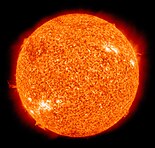太阳圈电流片

太阳圈电流片(Heliospheric current sheet,缩写为HCS)或太阳圈电流页[1][2]是太阳系内部磁场极性发生转换的表面,这个区域在太阳圈内沿著太阳赤道平面延伸[2][3]。电流片的形状是受到行星际物质中太阳磁场旋转的影响而形成的,厚度大约为10,000公里,有一小股电流在电流片中流动,大小约为10-10A/m2。
电流片下面的磁场称为行星际磁场,其产生的电流构成了一部分太阳圈电流回路[4]。太阳圈电流片有时也称为行星际电流片。
太阳圈电流片的特征[编辑]

由于太阳自转,磁场被扭曲成帕克螺旋(Parker spiral),这是阿基米德螺线的一种,是由尤金·帕克于1958年提出的[5],因而得名。电流片将帕克螺旋形状的磁场一分为二[6][7]。1970年代早期,Schatten发展出一个数学模型,当旋转的磁场改变极性时会翘曲、变形,形成类似芭蕾舞裙的波浪螺旋形状[8][9]。进一步的动力学研究表明,太阳如同一位害羞的女芭蕾舞演员,会将高高飘扬的裙摆反复向下压[10]。
这种芭蕾舞裙形状的成因有时被称为“水龙头效应”或者“橡胶软管效应”[11][12],好比一个人手执水龙头上下挥舞并且快速旋转。水流好比太阳风不断向外喷射。
太阳圈电流片的磁场[编辑]
太阳圈电流片随著太阳的自转每27天转一圈,在这期间地球的磁场会穿越其峰顶与谷底,并与之发生相互作用。在靠近太阳表面的地方,由电流片中的径向电流产生的磁场大约在5×10-6T量级[4]。太阳表面的磁场大小约为10-4T。如果是磁偶极场,其强度与距离的三次方成反比,地球轨道附近的磁场大约为10-11T。而实际上太阳磁场含有多极矩的成分,因此在地球附近实际大小要比这大100倍。
太阳圈电流片的电流[编辑]
太阳圈电流片中的电流向内流动,并与太阳磁场一道在太阳极区附近向外流动的电流构成闭合回路,总电流大约在3×109安培的数量级[4],太阳圈中电流密度最大的地方达到了10-10A/m2的数量级。与其它天体物理过程中的电流片相比,产生地球极光的白克兰电流只有大约100万安培,大小只有太阳圈电流片中电流的千分之一。
太阳圈电流片的研究历史[编辑]
太阳圈电流片是由翰M. 威尔科克斯和诺曼F. Ness在1965年提出的[13]。汉尼斯·阿尔文等人推测银河系也存在类似的星系电流片[14],估计电流大小为1017-1019安培,位于银河系的对称平面上。
参考文献[编辑]
- ^ 中央研究院天文及天文物理研究所翻译. 兩個北極的太陽. 中央研究院. 2003-04-22 [2022-04-17]. (原始内容存档于2008-01-27).
- ^ 2.0 2.1 Dr. Tony Phillips, A Star with two North Poles (页面存档备份,存于互联网档案馆), Science@NASA, 2003.04.22
- ^ Riley, Pete. Modeling the heliospheric current sheet: Solar cycle variations. Journal of Geophysical Research. 2002, 107 (A7): 1136. ISSN 0148-0227. doi:10.1029/2001JA000299 (英语).
- ^ 4.0 4.1 4.2 Israelevich, P. L.; Gombosi, T. I.; Ershkovich, A. I.; Hansen, K. C.; Groth, C. P. T.; DeZeeuw, D. L.; Powell, K. G. MHD simulation of the three-dimensional structure of the heliospheric current sheet. Astronomy & Astrophysics. 2001-09, 376 (1): 288–291. Bibcode:2001A&A...376..288I. ISSN 0004-6361. doi:10.1051/0004-6361:20010881.
- ^ Parker, E. N. Dynamics of the Interplanetary Gas and Magnetic Fields.. The Astrophysical Journal. 1958-11, 128: 664 [2022-04-17]. Bibcode:1958ApJ...128..664P. ISSN 0004-637X. doi:10.1086/146579. (原始内容存档于2019-10-28) (英语).
- ^ Schatten, Kenneth H. Prediction of coronal structure of the solar eclipse of October 23, 1976. Nature. 1976-12, 264 (5588): 730–731 [2022-04-17]. Bibcode:1976Natur.264..730S. ISSN 0028-0836. doi:10.1038/264730a0. (原始内容存档于2022-04-17) (英语).
- ^ Schatten, K. H. Current sheet magnetic model for the solar corona.. Cosmic Electrodynamics. 1971-01-01, 2: 232–245 [2022-04-17]. Bibcode:1971CosEl...2..232S. (原始内容存档于2022-04-29).
- ^ Rosenberg, Ronald L.; Coleman, Paul J. Heliographic latitude dependence of the dominant polarity of the interplanetary magnetic field. Journal of Geophysical Research. 1969-11-01, 74 (24): 5611–5622. Bibcode:1969JGR....74.5611R. doi:10.1029/JA074i024p05611 (英语).
- ^ Wilcox, J. M.; Scherrer, P. H.; Hoeksema, J. T. The origin of the warped heliospheric current sheet. NASA STI/Recon Technical Report N. 1980-03-01, 81: 33113 [2022-04-17]. Bibcode:1980STIN...8133113W. (原始内容存档于2022-04-17).
- ^ Mursula, K.; Hiltula, T. Bashful ballerina: Southward shifted heliospheric current sheet: BASHFUL BALLERINA. Geophysical Research Letters. 2003-11, 30 (22). Bibcode:2003GeoRL..30vSSC2M. doi:10.1029/2003GL018201 (英语).
- ^ Louise, K., Harra, K.O. Mason, Space Science, 2004, Imperial College Press, ISBN 1860943616.
- ^ Smith E. The Sun, Solar Wind, and Magnetic Field. BEACON eSpace at Jet Propulsion Laboratory. 1999 [2022-04-17]. (原始内容存档于2008-02-05).
- ^ Wilcox, John M.; Ness, Norman F. Quasi-stationary corotating structure in the interplanetary medium. Journal of Geophysical Research. 1965-12-01, 70 (23): 5793–5805. Bibcode:1965JGR....70.5793W. doi:10.1029/JZ070i023p05793 (英语).
- ^ Alfvén, Hannes; Carlqvist, Per. Interstellar clouds and the formation of stars. Astrophysics and Space Science. 1978, 55 (2): 487–509. Bibcode:1978Ap&SS..55..487A. ISSN 0004-640X. doi:10.1007/BF00642272 (英语).
外部链接[编辑]
| |||||||||||||||||||||||||||||||||||||
| |||||||||||||||||||||||||||||||||||||||||||||||

